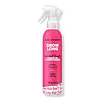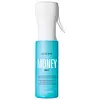What's inside
What's inside
 Key Ingredients
Key Ingredients

No key ingredients
 Benefits
Benefits

 Concerns
Concerns

 Ingredients Side-by-side
Ingredients Side-by-side

Water
Skin ConditioningCetyl Alcohol
EmollientBehentrimonium Chloride
PreservativeParfum
MaskingPhenoxyethanol
PreservativeCaffeine
Skin ConditioningTocopheryl Acetate
AntioxidantPanax Ginseng Root Extract
EmollientBiotin
AntiseborrhoeicCocos Nucifera Oil
MaskingStearyl Alcohol
EmollientPropylene Glycol
HumectantCyclopentasiloxane
EmollientDivinyldimethicone/Dimethicone Copolymer
Isopropyl Alcohol
SolventAmodimethicone
Ethylhexylglycerin
Skin ConditioningC12-13 Pareth-3
EmulsifyingCetrimonium Chloride
AntimicrobialTrideceth-12
EmulsifyingC12-13 Pareth-23
CleansingButylene Glycol
HumectantSodium Hydroxide
BufferingWater, Cetyl Alcohol, Behentrimonium Chloride, Parfum, Phenoxyethanol, Caffeine, Tocopheryl Acetate, Panax Ginseng Root Extract, Biotin, Cocos Nucifera Oil, Stearyl Alcohol, Propylene Glycol, Cyclopentasiloxane, Divinyldimethicone/Dimethicone Copolymer, Isopropyl Alcohol, Amodimethicone, Ethylhexylglycerin, C12-13 Pareth-3, Cetrimonium Chloride, Trideceth-12, C12-13 Pareth-23, Butylene Glycol, Sodium Hydroxide
Water
Skin ConditioningButylene Glycol
HumectantBehentrimonium Chloride
PreservativeCetyl Alcohol
EmollientPolyquaternium-55
Hydrolyzed Rice Protein
Skin ConditioningAdansonia Digitata Seed Extract
Skin ConditioningAmaranthus Caudatus Seed Extract
Skin ConditioningPropanediol
SolventStearamidopropyl Dimethylamine
EmulsifyingStearyl Alcohol
EmollientDicetyldimonium Chloride
EmulsifyingHydrolyzed Vegetable Protein Pg-Propyl Silanetriol
Skin ConditioningCrambe Maritima Leaf Extract
Skin ConditioningChlorella Pyrenoidosa Extract
Skin ConditioningChondrus Crispus Extract
Skin ConditioningUndaria Pinnatifida Extract
Skin ConditioningLaminaria Saccharina Extract
Skin ProtectingParfum
MaskingCeteareth-20
CleansingCaprylyl Glycol
EmollientPhenoxyethanol
PreservativeCitric Acid
BufferingPotassium Benzoate
PreservativeDimethicone
EmollientPotassium Sorbate
PreservativePropylene Glycol
HumectantSodium Benzoate
MaskingDisodium EDTA
Isopropyl Alcohol
SolventBenzyl Salicylate
PerfumingAlpha-Isomethyl Ionone
PerfumingWater, Butylene Glycol, Behentrimonium Chloride, Cetyl Alcohol, Polyquaternium-55, Hydrolyzed Rice Protein, Adansonia Digitata Seed Extract, Amaranthus Caudatus Seed Extract, Propanediol, Stearamidopropyl Dimethylamine, Stearyl Alcohol, Dicetyldimonium Chloride, Hydrolyzed Vegetable Protein Pg-Propyl Silanetriol, Crambe Maritima Leaf Extract, Chlorella Pyrenoidosa Extract, Chondrus Crispus Extract, Undaria Pinnatifida Extract, Laminaria Saccharina Extract, Parfum, Ceteareth-20, Caprylyl Glycol, Phenoxyethanol, Citric Acid, Potassium Benzoate, Dimethicone, Potassium Sorbate, Propylene Glycol, Sodium Benzoate, Disodium EDTA, Isopropyl Alcohol, Benzyl Salicylate, Alpha-Isomethyl Ionone
 Reviews
Reviews

Ingredients Explained
These ingredients are found in both products.
Ingredients higher up in an ingredient list are typically present in a larger amount.
This ingredient is a preservative and often used for it's anti-static properties. You'll most likely see this ingredient in hair conditioners.
It does not cause irritation or sensitization in leave-on products at 1-5%.
Butylene Glycol (or BG) is used within cosmetic products for a few different reasons:
Overall, Butylene Glycol is a safe and well-rounded ingredient that works well with other ingredients.
Though this ingredient works well with most skin types, some people with sensitive skin may experience a reaction such as allergic rashes, closed comedones, or itchiness.
Learn more about Butylene GlycolCetyl Alcohol is a fatty alcohol. Fatty Alcohols are most often used as an emollient or to thicken a product.
Its main roles are:
Though it has "alcohol" in the name, it is not related to denatured alcohol or ethyl alcohol.
The FDA allows products labeled "alcohol-free" to have fatty alcohols.
Learn more about Cetyl AlcoholIsopropyl Alcohol is more commonly known as rubbing alcohol. It is most commonly used as a solvent, meaning it helps other ingredients dissolve.
This ingredient is an astringent alcohol. Astringent alcohols may also irritate skin as they high amounts may strip away your skin's natural oils.
Other types of astringent alcohols include:
According to the National Rosacea Society based in the US, you should be mindful of products with these alcohols in the top half of ingredients.
Any type of sanitizing product will have high amounts of alcohol to help kill bacteria and viruses.
Learn more about Isopropyl AlcoholParfum is a catch-all term for an ingredient or more that is used to give a scent to products.
Also called "fragrance", this ingredient can be a blend of hundreds of chemicals or plant oils. This means every product with "fragrance" or "parfum" in the ingredients list is a different mixture.
For instance, Habanolide is a proprietary trade name for a specific aroma chemical. When used as a fragrance ingredient in cosmetics, most aroma chemicals fall under the broad labeling category of “FRAGRANCE” or “PARFUM” according to EU and US regulations.
The term 'parfum' or 'fragrance' is not regulated in many countries. In many cases, it is up to the brand to define this term.
For instance, many brands choose to label themselves as "fragrance-free" because they are not using synthetic fragrances. However, their products may still contain ingredients such as essential oils that are considered a fragrance by INCI standards.
One example is Calendula flower extract. Calendula is an essential oil that still imparts a scent or 'fragrance'.
Depending on the blend, the ingredients in the mixture can cause allergies and sensitivities on the skin. Some ingredients that are known EU allergens include linalool and citronellol.
Parfum can also be used to mask or cover an unpleasant scent.
The bottom line is: not all fragrances/parfum/ingredients are created equally. If you are worried about fragrances, we recommend taking a closer look at an ingredient. And of course, we always recommend speaking with a professional.
Learn more about ParfumPhenoxyethanol is a preservative that has germicide, antimicrobial, and aromatic properties. Studies show that phenoxyethanol can prevent microbial growth. By itself, it has a scent that is similar to that of a rose.
It's often used in formulations along with Caprylyl Glycol to preserve the shelf life of products.
Propylene Glycol is an odorless, colorless liquid. As a humectant, it helps skin retain moisture. It also aids in delivering active ingredients.
Another role of this ingredient is preventing a product from melting or freezing. Propylene glycol also adds antimicrobrial properties to a product, elongating product lifespan.
This ingredient is considered an organic alcohol and commonly added into both cosmetics and foods.
Those with sensitive skin or conditions may develop a rash when using this ingredient.
Learn more about Propylene GlycolStearyl Alcohol is a type of fatty alcohol from stearic acid. It is a white, waxy compound used to emulsify ingredients.
Fatty Alcohols are most often used as an emollient or to thicken a product. Emollients help soothe and hydrate the skin by trapping moisture.
They are usually derived from natural fats and oils and therefore do not have the same drying or irritating effect as solvent alcohols. FDA allows products labeled "alcohol-free" to have fatty alcohols.
Learn more about Stearyl AlcoholWater. It's the most common cosmetic ingredient of all. You'll usually see it at the top of ingredient lists, meaning that it makes up the largest part of the product.
So why is it so popular? Water most often acts as a solvent - this means that it helps dissolve other ingredients into the formulation.
You'll also recognize water as that liquid we all need to stay alive. If you see this, drink a glass of water. Stay hydrated!
Learn more about Water